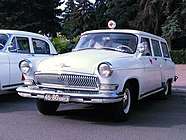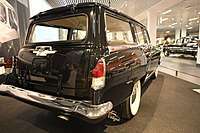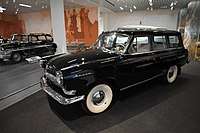GAZ-21
The GAZ M21 Volga is an automobile which was produced in the Soviet Union by GAZ ("Gorkovsky Avtomobilniy Zavod", in English : "Gorky automobile factory") from 1956 to 1970. The first car to carry the Volga name, it was developed in the early 1950s. Volgas were built with high ground clearance (which gives it a specific "high" look, contrary to "low-long-sleek" look of Western cars of similar design), rugged suspension, strong and forgiving engine, and rustproofing on a scale unheard of in the 1950s.
| GAZ-21 | |
|---|---|
.jpg) | |
| Overview | |
| Manufacturer | GAZ |
| Production | 1956–1970 |
| Body and chassis | |
| Class | Executive car (E) |
| Body style |
|
| Powertrain | |
| Engine | |
| Transmission |
|
| Dimensions | |
| Wheelbase | 2,700 mm (110 in)[1] |
| Length | 4,810 mm (189 in) |
| Width | 1,800 mm (71 in) |
| Height | 1,610 mm (63 in) |
| Chronology | |
| Predecessor | GAZ-M20 Pobeda |
| Successor | Volga GAZ-24 |
The Volga was stylistically in line with the major American manufacturers of the period in which it was introduced, and incorporated such then-luxury features as the reclining front seat, cigarette lighter, heater, windshield washer and 3-wave radio.
When in 1959 the six-cylinder line of GAZ cars was discontinued, Volga M-21 became the biggest and most luxurious car officially sold to individual owners in the USSR in large quantities, though its price was very high and made it unavailable for most car buyers. 639,478 cars were produced in total.[2]
The three series of GAZ-21
Three series GAZ-21 were released, most easily distinguished by the grille. The First Series (1956–58), known as the Star, featured a lattice of three large horizontal bars in the centre of which was a medallion with a star. Vehicles of the Second Series (1958–1962), known as the Shark, featured a grille with 16 vertical slits. Finally, the Third Series (1962–1970), known as the Baleen, featured a grille with 34 thin vertical rods.
_%22Volga%22_in_Moscow_(front_view).jpg)
First Series 1956–1958
The design process leading to the GAZ 21 began in November 1953. Alexander Nevzorov, head of the design team, was given a free hand to develop whatever he wanted to reach the objective of competing with American automobiles.[3] The designer Lev Eremeyev decided to follow the fashion set by the Chevrolet Bel Air, Plymouth Savoy, and Ford Mainline; the finished product bears a resemblance to the 1955 Mainline,[3] although according to archive documents the latter was purchased for comparison and onroad testing by GAZ only in mid-1954 – after the first prototypes of the GAZ-21 had already been built and tested.[4][5] The prototype appeared in the first quarter of 1954, powered by an inline four with overhead camshaft (driven by chain) and cross-flow hemi head.[3] Since the OHV engine was not ready in time, production M21s had a 65 PS (48 kW; 64 hp) 2,432 cc (148.4 cu in) sidevalve four, based on the GAZ-20's. The Volga was offered with a three-speed transmission, either manual (with synchronized 2nd and 3rd gear) or automatic. Front suspension was independent, while the rear was a live axle with semi-elliptical springs; there were lever shock absorbers on all four corners.[3] Lubrication was by a central oiling system, from a drum and foot-operated pump; the oil lines were prone to puncturing, and not all of the nineteen lubricated points were supplied equally.[6] The Volga offered front seats able to fold flat (not unlike a contemporary Nash option) and came standard with cigarette lighter and a radio[7] (still optional on most U.S. cars).[8] There were three variants: the standard M21G, an M21B taxi (with a taximeter in place of the radio and bucket seats in front instead of a bench), and a tropical model, the M21GYU, all with the GAZ leaping deer hood ornament.[3][7] Drag coefficient was a surprisingly good 0.42.[7]
The Volga made its public debut in 1955, with a three cars on a demonstration drive from Moscow to the Crimea, two automatic models and a manual.[3] It was, however, still far from production-ready; in the first year, 1956, only five cars were assembled, the first on 10 October 1956.[3] Full-scale production began in 1957, with a list price of 5,400 rubles.[7] The new 1957 production cars, known as Series Ones, had a brand-new 2,445 cc (149.2 cu in) OHV engine, the first model produced by Zavolzhskiy Motorniy Zavod (Zavolzhye Engine Factory, ZMZ). Unusual for the era, it had aluminum block and head, with gear-driven camshaft and compression ratio of 6.6:1; it produced 70 PS (51 kW; 69 hp) at 4,000 rpm and 123 lb⋅ft (167 N⋅m) at 2,200 rpm.[7]
The automatic transmission model would soon be discontinued, with only 700 built: it was widely criticized as being too difficult for Soviet drivers to maintain, there were few service stations to do the work and few private mechanics qualified, and there was a shortage of transmission oil.[9] From 1958, a three-speed manual, with synchromesh on the top two gears, was the only transmission available; this would be the M21V, while the taxi became the M21A.[10] The automatic did go on to be used in the low-production GAZ-13 Chaika, which would also be maintained by professionals.[10] Standard equipment on all models included spare parts and two tool kits, with spanners, wrenches, screwdrivers, a tire pump, and a cans of paint to fix minor dings.[11]
There were also export models M21D with the manual transmission and M21E with the automatic, both with a higher 7.2:1 compression engine, producing 80 PS (59 kW; 79 hp).[10]
Cars produced in the fall of 1958 combined features of the First and Second Series.
_%22Volga%22_(front_view).jpg)
Second Series 1959–1962
Second Series Volgas were introduced in 1959, with a new grille painted the body color or in chrome. Halfway through the 1959 production run (model year 1959½), a vinyl cover was added to the dash.[12] Added were windscreen washers and tubeless tires.[12] Just before the second series production concluded, telescopic shocks replaced the lever type. The 1961 Volgas were priced at 5,100 rubles.[6]
Variants of the Series Two included the M21I and M21A taxi with the 70 PS (51 kW; 69 hp) inline four, and the M21K and right-hand drive M21H (for export) with the 80 PS (59 kW; 79 hp) engine.[6]
The Volga was shown at the 1958 Brussels World's Fair and together with the GAZ-52 truck and the GAZ-13 Chaika it won the award.[13] In the same year, production for export began.[6] The Second Series Volgas became known for having no frills but outstanding durability, helped by the 23 cm (9.1 in) ground clearance.[11] In 1959, a Volga took a class win at the Thousand Lakes Rally in Finland, and third at the Acropolis Rally.[6] That year, the central lubrication system was deleted, in favour of a more traditional local grease-application nipple.[6]
In early 1962, a small number of cars were built that combined features of the Second and Third Series.
Third Series 1962–1970
The Third Series was produced from 1962 to 1970. The 1962 models dropped the leaping deer hood ornament, and had a new grille.[6] It used a 6.7:1 compression engine of 75 PS (55 kW) with an optional 7.65:1 compression of 80 PS (59 kW; 79 hp) (usually reserved for the export models).[14] The headliner changed from cloth to vinyl, and the radio became optional.[14] It was offered as the standard M21L, M21T taxi, and right-hand drive M21N export model.[14]
Also in 1962, GAZ advertised a Station wagon/estate model, the M22; most of these were exported or reserved for official use.[14] The first station wagons/estates were delivered in 1963,[14] and were designated M22 (75 PS (55 kW)), M22G (export, 75 hp (56 kW; 76 PS)), M22T (export, 85 PS (63 kW)); ambulances were M22B (75 PS (55 kW)) and M22BK (85 PS (63 kW)).[15] An M22 prototype four-wheel drive station wagon/estate was also built, as was an M22A van.[15]
The Belgian importer Sobimpex N.V. assembled Volgas locally for sale in Western Europe. These were often fitted with diesel engines; the cars arrived in Antwerp without an engine and with the gearbox in the trunk. Originally (beginning in 1960) Sobimpex fitted a 1.6-liter Perkins 4.99 unit, a larger Rover engine supplanted that in 1963, and the more modern Indenor four-cylinder units replaced the Rover engine in 1964.[16] Belgian-built cars were marketed as "Scaldia-Volgas," named after the Latin name for the river Scheldt. While the diesel models cost considerably more than ones with the original engine, they were quite popular for their economy and reliability and outsold the petrol models in both Belgium and the Netherlands.[16]
Models
The car's large size and tough construction made it popular in the police and taxi trades, and V8-engined versions (designated GAZ M23) were produced for the KGB. An automatic transmission was briefly offered in the late 1950s, but later discontinued due to lack of service stations, and then through the 1960s on the KGB's V8 version only, with the driver's controls being very similar to the discontinued "civil" automatic.
The Volga M21 was produced in saloon form from 1956 to 1970 and station wagon form (GAZ M22 Universal) from 1962 to 1970. This left the design quite outdated by the 1960s. GAZ developed a boxier, more modern replacement and in 1970, the M21 platform was discontinued by GAZ. Until the late 1970s, however, spare parts were produced by different plants all over the USSR, and some plants were re-building M21s using spare parts, wrecked, and junked cars. In 1988, about 80,000 M21 Volgas were registered in the USSR.
One M21 was given to Yuri Gagarin after his orbital flight; Gagarin was very fond of his Volga.[17]
The UAZ-469 all-terrain vehicle uses a GAZ-21A engine, and the RAF-977 minibus used the GAZ-21 engine and drivetrain.
A special variant GAZ-23 Volga was produced for Soviet special services only, with 160 PS (120 kW) 5.53-litre V8 engine from the Chaika.[6] It allowed the M23 to reach 170 km/h (110 mph).[18] Only 603 of the M23s were built between 1962 and 1970.[6]
Gallery
Popular culture
- A GAZ 21 is the main car featured in Rammstein's music video for the song Du hast.
- In Soviet cult movie Beware of the Car (1966) Yuriy Detochkin, Russian Robin Hood, steals Volga cars from corrupt officials.
- The protagonist of the 2009 Russian superhero movie Black Lightning fights crime with his flying car, a black 1966 GAZ 21.[19]
References
- Gloor, Roger (2007). Alle Autos der 50er Jahre 1945 – 1960 [All the cars of the 1950s, 1945–1960] (in German) (1 ed.). Stuttgart: Motorbuch Verlag. ISBN 978-3-613-02808-1.
- Tverdiukova, Elena (11 February 2015). ""Стиляга" с волнистой обивкой: "Волга" ГАЗ-21 на экспорт" [Stylish with wavy upholstery: Volga GAZ-21 for export]. Rossiyskaya Gazeta (in Russian). Federal State Budgetary Institution.
- Thompson, Andy (2008), Cars of the Soviet Union: The Definite History, Sparkford, Yeovil, Somerset: Haynes, p. 61, ISBN 978 1 84425 483 5
- GAZ report on the Ford Mainline (PDF)
- An article on the history of the GAZ-21 in the Avtomobilny Modelizm magazine
- Thompson, p. 65.
- Thompson, p. 62.
- Flory, J. "Kelly", Jr. American Cars 1946–1959 (Jefferson, NC: McFarland & Coy, 2008), passim.
- Thompson, pp. 62–63.
- Thompson, p. 63.
- Thompson, p. 66.
- Thompson, p. 64.
- "Expo 1958". volga.nl.
- Thompson, p. 123.
- Thompson, p. 124.
- "Дизельные ГАЗ-21 "Волга" в Бельгии" [Diesel GAZ-21 "Volga" in Belgium]. GAZ21Volga.com (in Russian). Archived from the original on 25 February 2011.
- Thompson, p. 121.
- GAZ-21S Militsya, Avtomobil Na Sluzhbie, No.2, DeAgostini 2010, ISBN 978-5-9774-0418-1 (in Russian)
- Internet Movie Car Database: 1966 GAZ 21 Volga in Chernaya molniya, Movie, 2009
_%22Volga%22_in_Lithuania.jpg)
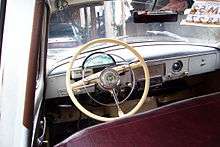
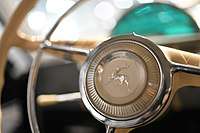
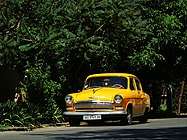
_%22Volga%22_in_Nizhny_Novgorod%2C_11_June_2009_(side_view).jpg)
_%22Volga%22_in_Nizhny_Novgorod%2C_11_June_2009_(rear_view).jpg)
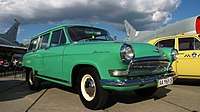
.jpg)
